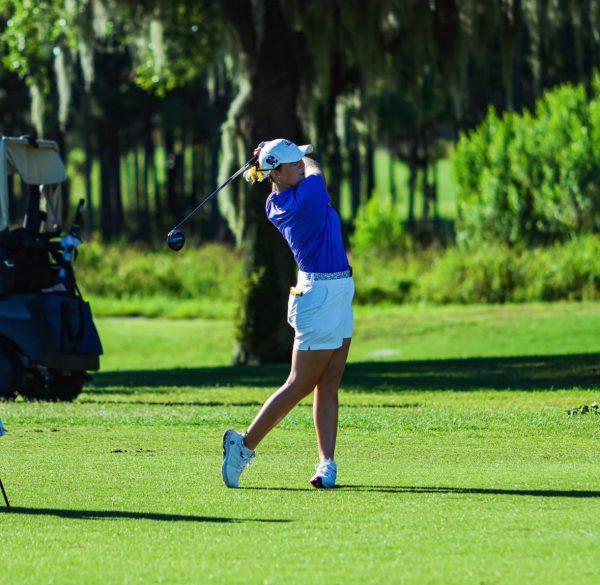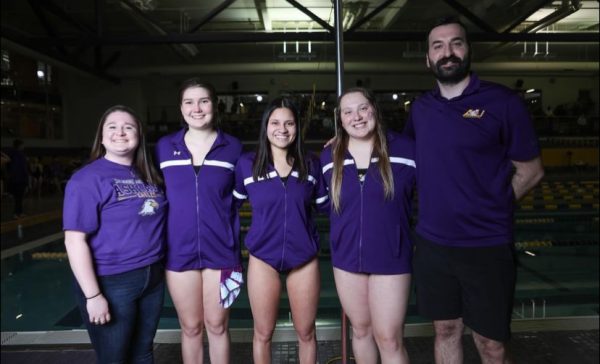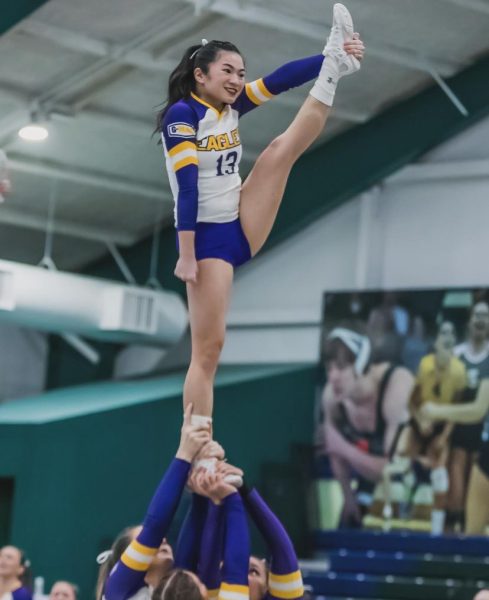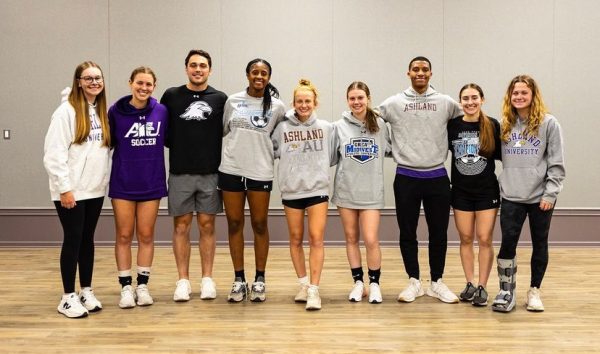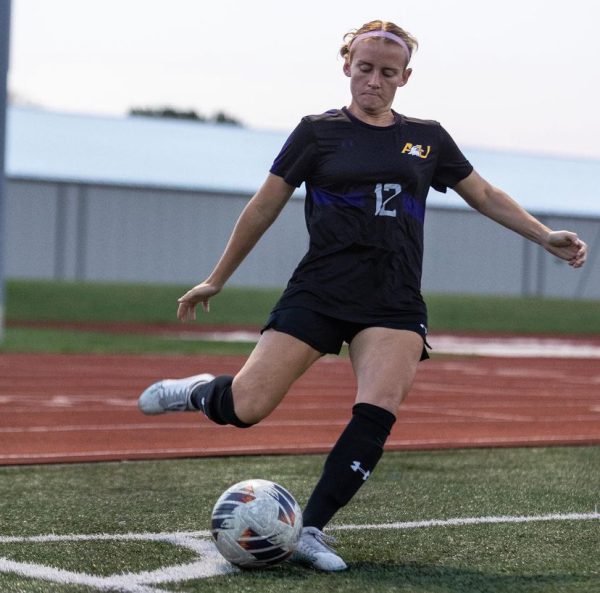“You can’t buy tradition”
October 4, 2012
This season, the crowds for football games at Jack Miller Stadium have been unlike anything Ashland University has ever seen. Average attendance has skyrocketed to over 4,500 per game, and head coach Lee Owens has expressed how much of a factor the home crowd has been in his team’s great start.
During Saturday’s game against Lake Erie, I wanted to see who all of these people are. Thus began my quest to watch the game from as many different spots as possible and get a feel for what brought everyone to the stadium.
• • • •
A cannon fired, the band began to play and Ashland’s football team took the field.
Inside Ashland University President Fred Finks’s loge, a group of donors turned their heads. If it was not for all of the noise, they might have forgotten there was a football game going on at all.
Fried oysters, pulled pork, hot dogs, baked beans, shrimp Caesar salad, a fruit platter with watermelon, cantaloupe, grapes—both purple and green—and pineapple, tortilla chips, vegetables, two types of dip, coffee and soft drinks had been laid out for a glorious dinner party.
On the field, Lake Erie’s Sam Marcotte kicked off to AU’s Chris Harvey to begin the game. Behind the glass of the loge, all that could be heard was dinner conversation.
Two women had just discovered they both went to Black River High School.
“First down, first down,” Finks said, as running back Anthony Taylor busted through the middle for five yards on Ashland’s second play from scrimmage.
“Yeah, we need to watch the game a little bit,” one of the women, Karen Baum, said.
Two plays later, quarterback Taylor Housewright scrambled away from a defender and completed a pass on the run to wide receiver Eric Thompkins for 19 yards, inciting a few claps and a loud whoop from the president.
The men began to gather in front of the window to watch the game, while the women moved nearer the food. Both groups continued to mingle.
With about 10:22 remaining in the first quarter and Ashland up 14-0, Finks led the men over to the food and grabbed some fried oysters.
“I told the coach if they wanted to score 100 points I would hold the one for them,” he said, and the group laughed.
• • • •
A few minutes later, he and Jack Miller, whom the stadium is named after, settled at a table together.
Miller, a 1974 graduate of Ashland whose floor in Kem Hall used to dominate in intramurals, was perhaps enjoying the game more than anyone.
This season, he and Finks have seen their vision for the new stadium come full circle. In its third season of use, Jack Miller Stadium—part of the Dwight Schar Athletic Complex— is more than just a shiny new building on campus.
As Owens said after the game, it is “the place to be in Ashland, Ohio on Saturday night.”
Saturday, 4,766 people watched the Eagles defeat the Storm 68-21 to move to 5-0 and bump themselves to No. 9 in the American Football Coaches Association Division II Coaches’ Poll.
“When we did this, the fundraising theme was ‘Bringing spirit to campus,’ and we really felt that if we could build a stadium on this campus we would have great turnouts,” Finks said.
The stadium, which according to Miller was built $800,000 under budget thanks in large part to the efforts of Finks, is worth more than the people it brings to campus on game days.
“You can’t buy tradition,” Miller said, pointing to the walls around the loge that have been plastered with pictures and plaques honoring AU football teams and players of the past.
• • • •
Outside, there were people enjoying the facility in a much different way.
Under the September twilight and the glow of the lights from the football stadium, a group of future AU students had started their own football game on the soccer field.
Impersonating Housewright, a young boy faked a handoff and floated a perfectly weighted pass to a receiver who had gotten open on the right side. The boy, aged about ten or twelve and wearing a black hoodie and jeans, caught the ball and ran about five yards before being dragged down from behind on the artificial turf. He took a few minutes to get up.
“It’s like it rubbed off the top layer of skin,” he said, rolling up his pant leg to inspect his right knee.
After all of the boys had a look, the game continued.
• • • •
Back inside the stadium, South Central High School’s football team watched Ashland’s Cameron Casey boot a 26-yard field goal to make the score 24-7 with 5:39 left in the second quarter.
Fresh off of a 22-7 win over Crestview to bump their record to 2-4, South Central head coach Aaron Brokaw wanted his team to see a higher level of football and hopefully learn from it.
They sat near the top of the stadium along the 30 yard line nearest the Northwest end.
Senior Hayden Dotson began the year at quarterback for the Trojans but was forced to move to wide receiver when the team’s main target got injured.
“How much faster the game is,” he said when asked what he and his teammates were learning. “How much harder you’re going to have to work to get to the next level.”
A few seconds later, Thompkins blew by his defender along the left sideline and received a 53-yard touchdown pass from Housewright. Casey’s kick made it 31-7.
Saturday’s game was Dotson’s first at AU. Since he lives nearby, he hears plenty of chatter when the team is doing well and follows the Eagles through the Ashland Times-Gazette.
He thinks he will come back in the near future.
“Sure, you can sit on your couch and probably see everything better on TV,” he said. “But I like the atmosphere of being at the stadium and seeing other fans cheering.”
• • • •
Val Harris is a 1970 graduate of Ashland who was a part of the 1967 team that went undefeated. He spent halftime munching on chips and pretzels and mingling with the Gridiron Club, which was gathered upstairs in the Troop Center.
He has been blown away by the improvements Ashland has made in recent years, especially the football facilities.
“There just can’t be anything better than this (in Division II), there just can’t,” he said.
When Harris played, Community Stadium was fairly new. Still, he said, it was a pain to share with Ashland High School. The team had to be bused to the stadium and would sometimes play on a grass field that had been ripped to shreds the night before.
Jim Phipps and Gary Beal played before Harris, and they can remember picking stones out of their elbows after practices at Redwood Stadium on campus.
Phipps and Beal graduated in 1966 as a part of the first class to have a winning record over four seasons (27-8-3) under head coach Fred Martinelli, for whom the field at Jack Miller Stadium is named. They barely recognized the football being played in front of them during the third quarter.
“There’s no comparison,” Phipps said. “Hell, the equipment’s all better.”
The Gridiron Club, founded in 2006, has given former players such as Harris, Phipps and Beal a chance to gather during football games and reminisce about their playing days. These men are walking proof of the tradition Jack Miller Stadium has put on display.
• • • •
Right next to the Gridiron Club is possibly the best place to watch a game at Jack Miller Stadium. Connected to the Troop Center behind the field goal posts is a balcony reserved for VIPs.
Late in the third quarter, about a dozen people were enjoying the view and the game.
Among those people was Dr. Dwight McElfresh, dean of the Founders School of Continued Learning.
“This is the most wonderful place to watch a ball game,” he said.
McElfresh graduated from AU in 1974 and received his doctorate from the school in 1992. He has noticed a definite difference in the game day atmosphere since the Eagles moved on campus.
“I was here an hour before the game and it was crazy outside,” he said.
Looking out over the packed stadium, McElfresh called the sporting atmosphere “collegiate,” something that could not have been said a few years ago. Even with the game well in hand, he joined the crowd to help push the Eagles to another touchdown late in the third quarter.
On third and one from the three yard line, running back Anthony Taylor dove into the end zone to make it 47-14.
“That’s it!” cheered McElfresh, as a family on the balcony gathered for a picture during the extra point attempt.
• • • •
If AU’s football program wanted to arrive on campus with a bang, Dave Brockway has been an integral part. He, Ron Roland and Wayne Williams operate the cannon that goes off every time the Eagles score.
“(Athletic Director) Bill Goldring called and said they wanted something special,” Brockway said.
He, Roland and Williams are a part of the First Ohio Light Artillery Battery D, one of two gun crews out of Ashland County. The battery travels around the country reenacting battles and marching in parades. It also sponsors the Ohio Civil War Show in Mansfield.
“Whenever we can go boom, we’re happy to do it,” Brockway said.
Each “boom” takes an eight-ounce bag of gunpowder. That means (including pregame and postgame blasts) Brockway went through 104 ounces of gunpowder Saturday night.
As Ashland drove down the field to start the fourth quarter, Brockway used the rammer to shove another pouch into the cannon. He began to explain the process of firing, then stopped.
“Do you want to shoot one off?” he asked.
It was an offer I couldn’t refuse.
So, when Anthony Capasso caught a nine-yard touchdown pass with 11:50 left to make the score 54-21, I held a piece of string, called a lanyard, taught while Brockway poked the bag of gunpowder with an iron rod called a punch. Then, a piece of metal about the size and shape of a key (called a friction primer) that was attached to the lanyard was put in a small hole above where the powder was stored.
I pulled on the lanyard with all of my weight, yanking the friction primer free.
“BOOM.”





